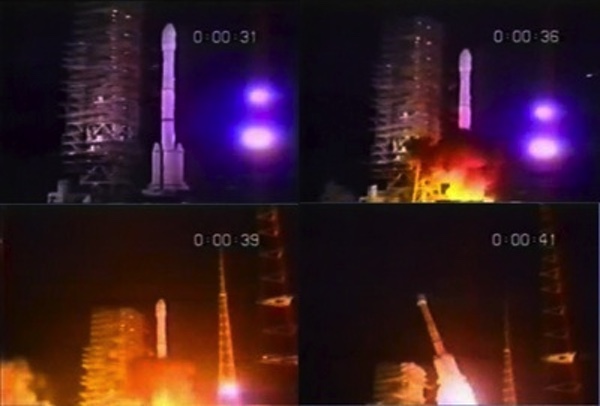Anything but expendable (part 1)A history of the Evolved Expendable Launch Vehicle (EELV) Secondary Payload Adapter (ESPA)by Darren A. Raspa
|
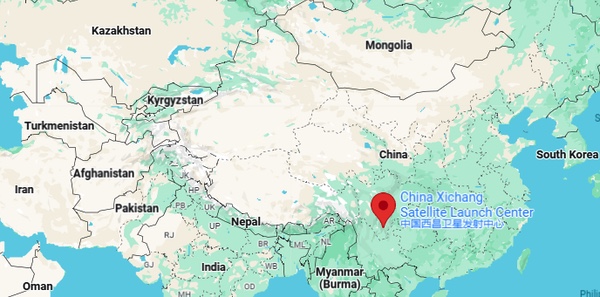 Figure 2. Xichang Satellite Launch Center (XSLC) in Sichuan Province is responsible for many civil, scientific, and military launches by the PRC since 1984. |
On the other side of the globe from the Space Systems Loral building in California, in Xichang, China, a party atmosphere prevailed the night of the launch. “Everybody was dressed in his or her best clothes,” remembered Bruce Campbell, a safety specialist contracted to prep the sat for launch on site by Loral. The launch window opened at 2:51 AM, but a nine-minute hold was inserted by Xichang operators to secure a more “auspicious” hour of 3:00 AM. Campbell and other American test engineers not directly involved in the launch went up to the roof of the satellite processing building to watch the event. The pad was out of view from the roof, hidden behind a ridge, but the rocket would be visible after it cleared the gantry and began its ascent. The surrounding residential villages were quiet as farmers and their families slept before work began at dawn.
The Loral team in Palo Alto knew there was a problem before the engineers on the roof did.
Two seconds after liftoff, Loral engineers watched on screen as the rocket went into a marked pitch, a fatal angle that only grew suddenly and drastically horizontal. In Xichang, the realization came soon after. “[I]nstead of rising vertically for nine seconds and several thousand feet [before starting to arc toward the east],” Campbell remembers, “I saw it traveling horizontally, accelerating as it progressed down the valley, only a few hundred feet off the ground.” The 426-ton Long March rocket accelerated for 22 seconds towards a hotel and residential complex, loaded with rocket-grade RP-1 and liquid oxygen propellant.
The payload section—including Intelsat-708—broke off first, before the entire launch vehicle impacted a hillside. Night turned into day, and the resulting shockwave could be felt for miles. In nearby Mayelin village, every house was leveled. The wail of ambulances echoed in the valley where cheers for liftoff had been heard only minutes before.
The resulting investigation found that the rocket’s flight control system was to blame for the six deaths and 57 injuries officially counted by the Chinese investigators. The unofficial death toll likely ranks in the hundreds. Subsequent visits to the site by Campbell and others found the village neighboring the launch complex no longer exists.[1]
| Rather than creating a cathartic moment of positive change, the Space Shuttle Challenger disaster ushered in an era in which it had become more expensive and more dangerous than ever to launch vehicles into space. If the space industry was to survive, something had to change. |
The Intelsat-708 incident was only one of several successive disasters that plagued the US space industry from the late 1990s to early 2000s.[2] Two years later, on May 19, 1998, a problem on a telecommunications satellite orbiting 36,000 kilometers above the Earth shut down gasoline pumps, television stations, and pagers across the US. Mechanical engineer and spacecraft vibration isolation expert Joe Maly and his boss, CSA Engineering President Conor Johnson, were in Washington, DC, for a meeting at the Pentagon when the BlackBerry device Johnson was using suddenly stopped working.[3] “I only went to the Pentagon twice in my career, so it was a memorable trip,” Maly recalls.
CSA Engineering had recently been awarded a Small Business Innovation Research (SBIR) grant from the Air Force Research Laboratory (AFRL) Space Vehicles Directorate in New Mexico to work on a novel payload adapter when the orbital failure struck.[4] Johnson’s BlackBerry was not the only device affected that day; indeed, 80% of US paging and mobile devices went offline for at least 24 hours, as did the entire Reuters news service, CBS, and National Public Radio. More than a mere annoyance, the incident highlighted the growing reliance on space in daily terrestrial affairs in the late 1990s, which has increased a thousand-fold in the three decades to follow.[5]
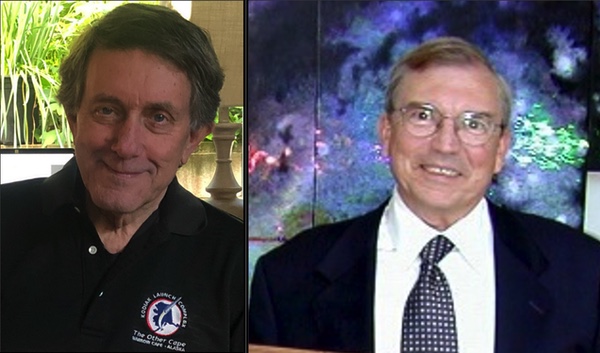 Figure 3. CSA/Moog’s (L to R) Joseph R. Maly and Conor Johnson. |
Only a few months after the Galaxy IV incident, in September of 1998, Loral was hit once again with a satellite loss. A Zenit-2 launch vehicle burned up in the atmosphere five minutes after launch from the Baikonur Cosmodrome in Kazakhstan, along with the 12 Globalstar telecommunications satellites on board, after a glitch in the rocket’s Ukrainian-manufactured control system shut down the engines.[6]
The commercial space industry was not alone in the failures of the 1990s. Six months after the Galaxy IV incident, on April 9, 1999, a Defense Support Program (DSP) spacecraft launched aboard a Titan IVB booster with an Inertial Upper Stage (IUS) bound for a geosynchronous (GEO) orbit from Cape Canaveral’s SLC-41 pad. The booster strap-on motors and the first and second stages went off without a hitch, as did the first stage of the IUS. The second stage of the IUS fired next, but rather than heading for the intended GEO orbit, the IUS had been launched into a useless orbit; the spacecraft was not recovered.
Less than a month later, on April 30, 1999, the Titan IV experienced another failure, this time carrying a US Air Force Milstar space vehicle. Everything checked out during the Titan’s flight, but problems soon developed during the Centaur second stage rocket’s first burn, followed by the vehicle going out of control during the second burn. Once again, a military satellite worth hundreds of millions in taxpayer dollars was placed into a useless orbit.
Investigations of the two DoD launch incidents found quality control to blame. In the first Titan IV launch, the insulating tape intended to be wrapped around the wiring harness of the IUS for thermal protection purposes had been carelessly wrapped over an electrical connector that was supposed to separate when the first stage had completed its mission; on the second Titan failure, the Centaur roll damping constant was entered as -0.199 rather than the required –1.99, which led to unnecessary maneuvering during the first Centaur burn and the depletion of the attitude control propellant that the vehicle needed for the second burn.
 Figure 4. US launch industry failures, 1980 to 2000. Note the sharp increase in pre-and post-launch failures in the mid-to-late 1990s. |
The above is only a sampling of the losses experience by the US space industry between 1998 and 2000. Rather than creating a cathartic moment of positive change, the Space Shuttle Challenger disaster ushered in an era in which it had become more expensive and more dangerous than ever to launch vehicles into space. If the space industry was to survive, something had to change. And that change would come from a combined group of young officers, civilian, and industry scientists and engineers supporting a lab with a brand-new name, but a long history in historic aerospace research and development milestones.
Part 1: Getting to space: The origins of AFRL’s Space Vehicles Directorate, 1945–1993
The Cambridge Lab
On the westernmost outskirts of Kirtland Air Force Base in Albuquerque, New Mexico, scientists and engineers have been working to make the assured access to space its top priority for the past eight decades. The AFRL Space Vehicles Directorate and its predecessors have continuously made the cutting-edge breakthroughs that have pushed the envelope in space science and engineering R&D.
After World War II, the development and advancement of the jet engine allowed the Army Air Forces to go farther, faster, and higher than ever before. However, the problem remained that weather patterns and high-altitude atmospheric turbulence were still unpredictable, and, in some higher altitudes, entirely unknown. Ideological and political differences between the Soviet Union and United States and Allies emerged in July 1945, even before the dropping of the bombs on Hiroshima and Nagasaki, at the Potsdam Conference. A nuclear world, it would seem, would not be one in which assured destruction via an atomic “superweapon” would usher in an era of peace. During this new “cold” war, the need for reliable forecasting of the weather would prove key for reconnaissance, air-to-air refueling, and the technological push to the upper atmosphere and beyond with ballistic missile technology. Seeing the need to maintain the edge in scientific development, the Army Air Forces began recruiting scientific personnel at the Massachusetts Institute of Technology (MIT) Radiation Laboratory and Harvard University's Radio Research Laboratory for post-war employment at the Cambridge Field Station (CFS) in Massachusetts under the jurisdiction of the Watson Laboratories at Red Bank, New Jersey. On September 20, 1945, a young field-grade officer, Major John W. Marchetti, was appointed Commander (Acting) of the new Army Air Forces Cambridge Field Station.
Located on Albany Street in Cambridge, Massachusetts in the aging dormitories of MIT, personnel of the Cambridge Field Station would, like rocket pioneer Robert Goddard before them, first travel from Massachusetts to New Mexico for the unobstructed and wide-open test space it provided. Wernher von Braun and his team of rocket scientists, fresh from the German Peenemünde Army Research Center, had been absorbed into the American space R&D effort following Operation Paperclip at the end of World War II and were now actively engaged in upgrades and modifications to their Vergeltungswaffe (“Vengeance Weapon”) model two—or V-2—rocket.
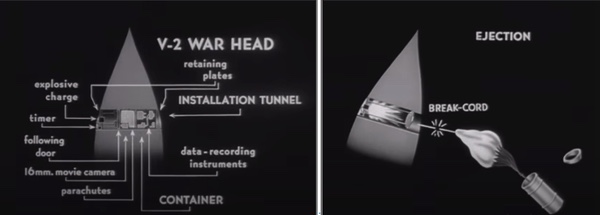 Figure 5. AFRL’s first payload adapter system was developed for the Project Blossom V-2 rocket tests in 1947. (From, “Film Report WF12-114, ‘Project Blossom 1,” Air Material Command Engineering Division, Motion Picture Section, Photographic Division, T-2 Intelligence, White Sands, New Mexico, March 1947, AFRL Phillips Research Site History Office and Archives Collection). |
The United States began launching reconstructed V-2s from the Army’s White Sands Proving Grounds in May of 1946. Under the direction of CFS’s Navigation Lab Chief Dr. Marcus O’Day, the Lab’s photoelectric methods for measuring radiation were being tested. O’Day and his “Project Blossom” Cambridge Lab S&Es (scientists and engineers) managed to push their rockets above the Kennelly-Heavyside E Layer of the atmosphere to more than 100 miles (160 kilometers) above the Earth. At the appropriate altitude, a box—arguably the first “CubeSat” containing instruments and cameras— ejected from the warhead and slowly lowered to the ground by means of special Lab-designed parachutes. In this manner, previously unknown weather and technical data about the upper atmosphere were collected. “Blossom” improved on near-orbital photography, reconnaissance, parachute, and payload adapter technology and set the stage for the Air Force Research Lab’s pushing the boundaries of space science and engineering.[7]
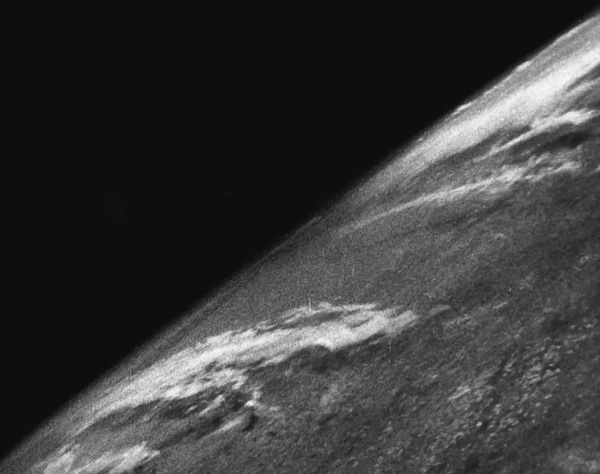 Figure 6. First photograph of the Earth from space, October 24, 1946. A 35-millimeter motion picture camera was launched aboard a V-2 rocket at an altitude of 65 miles on the edge of space. The V-2 testbed would provide the early Air Force Research Lab Space Vehicles Directorate with knowledge of the upper atmosphere and improve upon payload adapter design. (Source: White Sands Missile Range Museum). |
The Cambridge Field Station was renamed the Air Force Cambridge Field Station Geophysics Research Directorate in 1947 with the birth of the independent Air Force, and the Air Force Cambridge Research Laboratories (AFCRL) in 1949 would continue to develop hardware and nascent computer chip technology to understand weather patterns and atmospheric turbulence at higher altitudes into the 1950s and ’60s. In a Cold War world—the US had detected the Soviet Union’s first test of a thermonuclear device in the late summer of 1949—military detection and targeting systems, and therefore access to space, became a Department of Defense imperative.[8]
Sputnik, SESP, and the early DoD Space Test Program
The launch of the Soviet Sputnik I satellite in 1957 instantly made space the fourth possible theater of war. If the Russians could get to space, they could theoretically drop a nuke on an American city. “Space is hard” is a truism that lasts to the present day and originates in the first failed attempts at developing and launching satellites for military use. Before space technology could be relied upon in an operational environment, it needed to be tested in a real-world orbital environment. The National Aeronautics and Space Administration (NASA) had been created in the summer of 1958 to develop the civilian space program, but growing American assets on orbit highlighted the need to protect and defend those assets with reliable military space systems. President John F. Kennedy had delivered his “We Choose the Moon” speech at Rice University and NASA astronaut Ed White had walked in space, but by the end of 1965 no organization or funding lines existed to test military spaceflight experiments and demonstrations.[9]
| The astronauts, unfamiliar with the reference, opened the safe and removed the checklist to look up the term. A quick review found Tab Echo’s translation: “store checklist.” |
John S. Foster, Under Secretary of Defense Research and Engineering (DDR&E), had the responsibility of formulating a plan for research, development, testing, and engineering for the entire Department of Defense. Foster had cut his teeth during World War II as a physicist attached to Harvard’s Radio Research Lab, which along with MIT’s Radiation Lab had combined to form the Air Force Cambridge Research Lab after the war. Prior to his appointment to the DoD, Foster had been recruited personally by Edward Teller to work as the division lead in experimental physics at Lawrence Livermore Lab. He quickly rose through the ranks to become associate director in 1958 and director in 1961, a post he held until his appointment as DDR&E in 1965 by Secretary of Defense Robert S. McNamara under President Lyndon Johnson. In July of 1966, after reviewing the development status of weapons systems that the services presented to Secretary of the Air Force (SECAF) Harold Brown for production approval, Foster drafted the memo that would finally provide spaceflight for DoD experiments that did not have their own means of flight. The Space Test Program (STP) was born, thus pioneering a program that would give wings to the experimental ESPA program four decades later.[10]
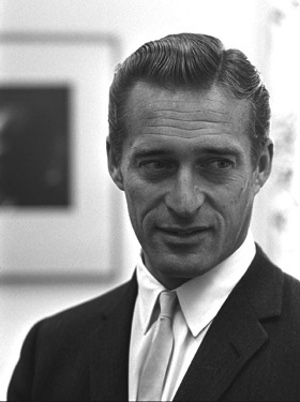 Figure 7. John S. Foster, Jr. would form what would become the STP program in 1966 during his tenure as Under Secretary for Defense Research and Engineering. (Source: Lyndon Baines Johnson Library and Museum). |
Founded as the Space Experiment Support Program (SESP), the office was created to safely and economically advance developmental programs for the DoD services. SESP was organized into three initial categories of development: experiments related to systems or subsystems, experiments measuring and analyzing the space environment, and experiments exploring the benefits of a manned military space mission. The first SESP mission, P67-1, was launched on June 29, 1967, from Vandenberg Air Force Base (now Vandenberg Space Force Base) aboard a Thor-LV2F Burner-2 Star-13A rocket. P67-1 consisted of an Army program, the Sequential Collation of Range-9 (SECOR 9), and a Navy program, Aurora 1, whose missions were to improve global geodetic survey accuracy and collect data on background radiation in ultraviolet wavelengths, respectively. Both experiments were 100% successful. Data from SECOR 9 was used for military target location and mapping while data from Aurora 1 was used in the background radiation database for surveillance satellites.[11]
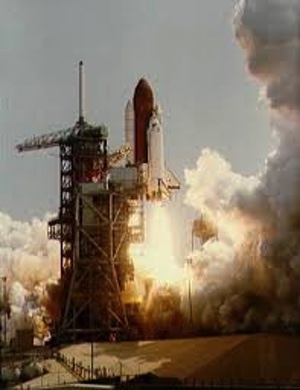 Figure 8. Columbia lifts off for the first DoD STP Space Shuttle mission, June 27, 1982. |
Even before men walked on the Moon, NASA and DoD had been analyzing the next platform for space experiments. Early designs for a space vehicle that would “shuttle” humans and experiments into orbit regularly intrigued SESP leadership. However, it was not until ten years later that Under Secretary of Defense for Research and Engineering William J. Perry under the Jimmy Carter Administration ordered STP (SESP had been renamed STP in 1971) to analyze the nascent Space Shuttle as a DoD “laboratory in space.” First launching on STS-4 aboard the Columbia under the command of pioneering space program astronaut Ken Mattingly (who was famously replaced on the Apollo 13 mission by Jack Swigert after being exposed to German measles—which he never caught) in the summer of 1982, the first STP Space Shuttle mission would yield data on navigation, plasma contamination, and the space environment. STP would ultimately fly 242 DoD experiments on 109 of the 135 total Space Shuttle missions until its retirement from service in 2011. Although a useful platform for DoD experiments, the dream of the Shuttle’s routine access to space fell short when launch rate promises failed to meet pro¬jected targets. To protect their launch requirements, Air Force and DoD leaders sought an alternative to assured access to space on more conventional rockets like the Titan. Additionally, the human element to Shuttle operations complicated military space launch.[12]
Classified challenges, the Challenger, and the origins of the EELV program
Well before the Challenger incident and mounting costs and delays at NASA, it was clear to DoD leadership that an uncrewed rocket platform was needed for military programs. Due to the differing goals of NASA and DoD for space experiments, complications arose first in 1979 during the selection of the first group of astronauts for military space experiment missions. DoD had selected a baker’s dozen of Manned Spaceflight Engineers (MSEs) as potential payload specialists, all but one of whom hailed from the Air Force. The plan was that these MSEs would assist during military-related missions and that civilian astronauts would work non-military payload elements. However, as mere “payload specialists” for very specific programs among several launching aboard any one shuttle mission, NASA culture cast the DoD MSEs as outsiders, almost guests, on a primarily civilian space science platform. Reinforcing this perception was NASA’s decision to authorize only one of the 13 military MSEs proposed from DoD’s first roster of astronauts for spaceflight. Among the first and follow on groups of Shuttle astronauts, tensions existed between the military and civilian astronauts.
Ken Mattingly, who commanded the first STP mission on Columbia, later described the relationship between NASA and the DoD specialists as “sour.” Classified payloads compounded this challenge. For example, the control center for classified Air Force programs riding on the Shuttle platform was located in Sunnyvale, California. However, Houston and Columbia communicated over the open channel but did not have a code word selected for mentioning Sunnyvale programs. Code word challenges continued on STS-4 during the seventh day of the mission when Mattingly and pilot Hank Hartsfield were readying the ship for return to Earth. They had just stored the classified checklists in the safe when Sunnyvale radioed to have the crew perform “Tab Echo.” The astronauts, unfamiliar with the reference, opened the safe and removed the checklist to look up the term. A quick review found Tab Echo’s translation: “store checklist.”
During her preparation for STS-33, on which a classified DoD program was flying, NASA astronaut Kathy Thornton remembers, “Training schedules were coded. They would say things like ‘Event 7012.’ You had to open up the safe every morning to find out that Event 7012 was food tasting in another building, and you were already five minutes late.” On another shuttle mission flying a classified DoD program, Mattingly, Ellison Onizuka, Loren Shriver, and Jim Buchli were required to travel to Sunnyvale to be briefed and ordered to disguise their destination. They filed a flight plan for their T-38s for Denver, then diverted to the San Francisco Bay area. They landed their aircraft at NASA Ames in Mountain View and were ordered to use cash to rent a barely working car and stay at an out-of-the-way low-end motel. Taking a circuitous route to the motel that included several stops and reverses to throw any potential tails, the astronauts eventually arrived at their motel, only to see “WELCOME STS-51C ASTRONAUTS!” with all four of their names emblazoned on the roadside motel sign.
By January 1986 it was already clear the Air Force and DoD needed to return to uncrewed rockets to launch military space experiments. The loss of Challenger and the deaths of Sharon Christa McAuliffe, Gregory Jarvis, Judith Resnik, Dick Scobee, Ronald McNair, Mike Smith, and Ellison Onizuka was only the sad, final affirmation. Although DoD would continue to fly programs aboard the Shuttle platform following a 31-month launch ban by NASA that followed Challenger, a faster, more expendable means of launch was needed for military space access.[13]
“Space War I” and the evolution of DoD space launch systems, 1980s–1993
The two and a half years without a Space Shuttle forced both NASA and DoD to rethink the entire American space program. As during the Apollo mission, NASA turned to the Air Force. Systems engineering genius General Samuel C. Phillips had helped bring the Apollo program back from possible cancellation in the 1960s. Two decades later they once again looked to General Phillips, then in retirement, and the Air Force for guidance. Phillips, who was in his 60s and who had retired from government service as a four-star general in 1975, and his Rogers Commission report released in June 1986 recommended the Air Force and DoD focus on dependable uncrewed boost-ers and expendable launch vehicles that could quickly begin launching and begin putting a dent in the more than 25 military space missions in the post-Challenger backlog.[14]
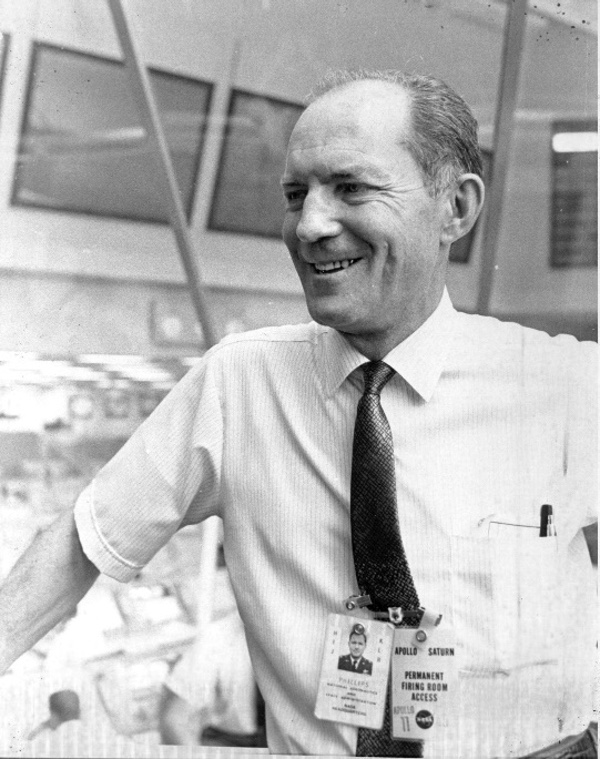 Figure 9. General Sam Phillips, famous for his management of the B-36, B-52, Thor, and Minuteman programs, would bring the Apollo program success in the 1960s and refocus space access in the 1980s. |
The Cold War was still on in the 1980s, and the nuclear mission’s no-fail requirement had driven the rise of big, expensive satellites with high mission assurance and system redundancy to last several years—if not decades—without maintenance on orbit. What was needed were large, rugged monstrosities like the MILSTARs. The MILSTAR 2 NC3 communications satellite, for example, had a 50-foot (15-meter) bus, a solar array twice that long, weighed 10,000 pounds (4,500 kilograms), cost $800 million, required a $433 million Titan IV rocket to launch, and took almost 11 years to launch from contract award in 1982 to delivery on orbit in 1993. Small satellites, or smallsats, were the realm of amateur space hobbyists.[15]
 Figure 10. Large, expensive satellites on the MILSTAR model was the order of the day for DoD space vehicles in the 1990s. (Image courtesy Air & Space Forces Magazine). |
Programs that suffered the most during this period were those designed specifically for the shuttle platform, such as the operational GPS satellite constellation, the early warning Defense Support Program (DSP), and National Reconnaissance Office (NRO) satellites. Shuttle-specific programs included satellites launched by the Air Force Geophysics Lab (AFGL), descendant of the Cambridge Research Lab. Across the services, the DoD had to quickly redesign their programs for expendable launch vehicle (ELV) compatibility.[16]
Before 1986, the Air Force fleet of ELVs consisted of Titan IIs, Titan 34Ds, and Atlas E/F/G and Hs; after the Challenger incident, Titan CELVs—re¬named Titan IVs—new Delta IIs, and Atlas II rockets would be added to the launch arsenal. Many of these were deactivated ICBMs and made for a rough ride for satellites, a challenge that would soon be addressed by the space folks at AFGL.
Each ELV booster and payload was unique, making integration of the two a months-long process. The Titan IV booster, for example, had to be custom fitted to each particular space vehicle. Payload fairing segments were often too large to install in an off-pad facility, requiring payload technicians to integrate the payload to the rocket on the pad, then install the fairing around it. In sum, integration complexity, cost, and limited flexibility to substitute missions created a call for a standardization booster modification kit. If any challenges arose in the integration process, delays would mount. In every space launch assessment following the Challenger flight moratorium, a key recommendation emerged: a standard payload adapter was desperately needed for rapid and sustained access to space.
| In every space launch assessment following the Challenger flight moratorium, a key recommendation emerged: a standard payload adapter was desperately needed for rapid and sustained access to space. |
In the spring before the return to flight for the Shuttle program, Air Force Chief of Staff General Larry Welch formed a Blue Ribbon Panel on Space Roles and Missions. The panel was comprised of high-ranking representatives from every Air Force major command. Their challenge: solve the Air Force space access problem. President Ronald Reagan’s Strategic Defense Initiative (SDI) was well underway when the Blue Ribbon Panel convened, but the role of space for the warfighter, space system responsiveness, and organizational and institutional relationship specifics were still unclear. The final report, produced in August, emphasized space policy that reflected realistic warfighting capabilities under four mission functions: space control, force application, force enhancement, and space support. In February 1989, Air Force headquarters issued an implementation plan that identified 27 specific actions necessary to accomplish the changes recommended by the panel. Among the most important: rapid and robust standardized space launch.
Air Force Space Command (AFSPC)—which was activated a year after the first Space Shuttle mission in September of 1982—was spearheading an initiative to develop a new fleet of launch vehicles that could provide low-cost access to space for a variety of payloads. With funding and untested technology always at stake, opposition was high to any new vehicles; the Pentagon opted for upgrades to existing launch systems rather than promising—but unproven—launch technology. As consolation, however, Air Force Space Policy was rewritten to transfer “space system requirements, advocacy, and operations, exclusive of developmental and, for the near term, launch systems” to Air Force Space Command. On October 1, 1990, all Systems Command launch-related centers, ranges, bases, and the Delta II and Atlas E missions would transfer to Space Command, with all remaining Atlas II, Titan II, and Titan IV missions to be transferred on a set schedule. A large step in operational space for the warfighter had just taken place, as it would turn out, two months into the world’s first “space war.”[17]
Less than a year after the fall of the Berlin Wall in August 1990, Iraq’s President Saddam Hussein invaded and overran the country of Kuwait. Within five days, under the operational name “Desert Shield,” allied United Nations (UN) forces began a military buildup in the region. It was time for AFSPC to try out its new role. At bat was a new Air Force laboratory, one of four research and development “super labs,” that had recently been formed to support transition of technology to the warfighter.
In the early days of AFSPC, Air Force Systems Command had created the Air Force Space Technology Center (AFSTC) on Kirtland AFB in October of 1982. The Air Force Weapons Lab (AFWL), which supported directed energy and radiation remediation and related nuclear simulation R&D on Kirtland, the Geophysics Lab, which continued the work of the Cambridge Lab in Massachusetts, and the Rocket Propulsion Lab on Edwards AFB in California reported to AFSTC. AFGL had studied the atmosphere and space environment since 1945, while the Rocket Propulsion Lab had developed and tested rocket boosters since 1947. AFSTC reported to the space product center, the Space and Missile Systems Center (SMC) on Los Angeles Air Force Base in order to make it more responsive to its customers’ needs and to focus its resources on timely technology transition.
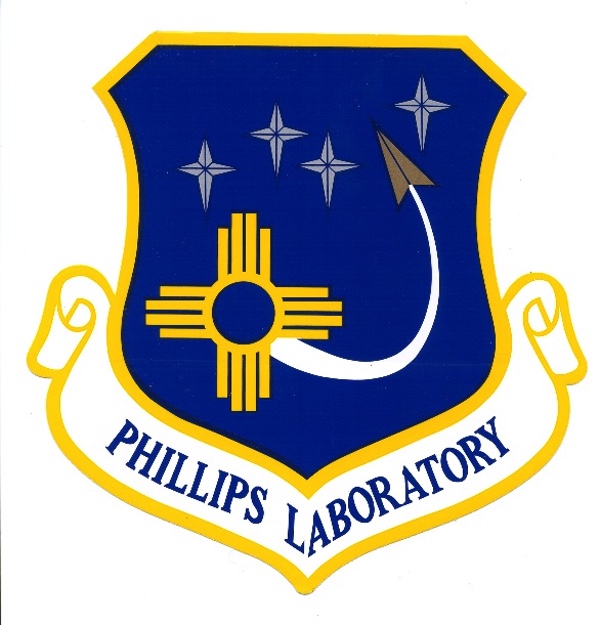 Figure 11. AFRL predecessor, the Phillips Lab, would prove foundational in increasing access to and operability in space. |
Four months after the invasion of Kuwait, in December of 1990 the Space Technology Center was redesignated the Air Force Phillips Laboratory (AFPL) and the three AFSTC subordinate labs were reassigned into six technology directorates for space and missile systems, geophysics, and advanced weapons R&D. It was no coincidence that the Air Force had named its new space lab in honor of the late General Phillips, who had passed away earlier in the year from a sudden and rapidly advancing cancer and who had made such an enormous impact in the Air Force and civilian space community. Indeed, at his retirement in 1975 as Commander of Systems Command, General Phillips predicted, “The importance of space to our defensive military effort can only increase in the future.”[18]
American military space power was under the microscope in January 1991 when Saddam Hussein’s deadline from the UN Security Council to withdraw from Kuwait went ignored: Operation Desert Shield was now “Desert Storm,” and the Persian Gulf War had begun. For the first time in American military history, space would play a central rather than corollary role in an international armed conflict. Taking point in this engagement was the work of US Space Command (USSPACECOM), which had stood up three years after AFPSC to command military operations in space, and AFSPC, supported by the space R&D effort at Phillips Lab. The force enhancement capabilities allowed by Phillips Lab space programs included knowledge of weather, strike planning, redirection, weapon loading, air refueling, and floodplain and other geographic information, as did the first military utilization of the Global Position System (GPS), which had launched aboard the DoD Navigation System with Timing and Ranging (NAVSTAR) satellite in 1978. Indeed, General “Stormin” Norman Schwarzkopf would highlight Air Force space R&D work in space as integral to his “Hail Mary” tank movement victories. Space forces had proved their worth through the nearly 60 military and civilian satellites influencing—and, in the realm of commercial space, televising—the course of the war.[19]
However, when US Central Command requested an additional DSCS III satellite shortly after the Kuwait invasion in the fall of 1990, USSPACECOM and AFSPC could not act: the launch needed to await completion of the Atlas II’s new Centaur upper stage, which was not scheduled until July 1991, nearly a full year later. This was not good for rapid response. Although six military satellites would join the existing network on orbit during the war, all of these had been previously scheduled months in advance. In the event of an all-out space war, Desert Shield put the spotlight on the fact that the US could not respond on short notice.[20]
Two months after the end of Gulf War hostilities, in April of 1991, the National Launch System (NLS) was created to solve the rapid space access problem following several high-level meetings with NASA, DoD, and the National Space Council. The NLS would form the basis for President George H. W. Bush’s National Space Policy Directive (NSPD) 4. The mission of the NLS was to “significantly improve the operational responsiveness of the entire space lift process, while reducing all costs” by launching medium to heavy payloads using “elements of existing launch systems and new technology.” NSPD 4 indicated this was to be accomplished through an intra-government partnership between the DoD and NASA for development, funding, and management of the program. The foundation of NLS was to pave the way for a standardized system of three launch vehicles, modular adaptable components, a standard engine, standardized interfaces, off-pad processing and encapsulation, and as many standard components and adapters as possible.[21]
The NASA/DoD relationship—specifically the partnership between the Air Force and NASA—had been dysfunctional from the start. Several months after the NLS proposal, a memorandum of understanding between the DoD and NASA was still unsigned. Undefined roles and responsibilities meant no funding, no acquisition strategy, no list of priorities, and no concept of operations. It came as no surprise to either agency in fiscal year 1993 when Congress terminated the program.
Entering the White House in January of 1993, President Bill Clinton’s administration conducted a bottom-up review of the space and defense budgets and found that, rather than supporting starting a new launch system from the ground up outright, other options existed. The first option relied on maintaining existing launch vehicles until 2030; the second option focused on developing a new series of expendable launch vehicles to replace the current fleet beginning in 2004; and a third option was to develop a reusable vehicle. Defense Secretary Les Aspin presented a fourth option that was ultimately accepted: a combination of utilizing existing launch vehicles while building a new fleet and creating standardized systems for both. In November 1993, Congress directed Secretary Aspin to “develop a plan that establishes and clearly defines priorities, goals, and milestones regarding modernization of space launch capabilities for the Department of Defense or, if appropriate, for the Government as a whole.” The stage had been set for renewed—or evolved—expendable launch vehicles: the EELV program.[22]
References
- Kurtis J. Zinger, “An Overreaction that Destroyed an Industry: The Past, Present, and Future of the U.S. Satellite Export Controls,” 2014; Chen Lan, “Mist Around the CZ-3B Disaster (Part 2),” SpaceNews, 8 Jul 2013; “Satellite Launches in the PRC: Loral,” US National Security and the People’s Republic of China; Anatoly Zak, “Disaster at Xichang,” Smithsonian Magazine, February 2013.
- Interview, Darren Raspa with Lisa Berenberg, Jeffrey Ganley, Gregory Sanford, and Peter Wegner, 30 January 2024, AFRL Phillips Research Site History Office and Archives Collection.
- See J.P Den Hartog’s seminal Mechanical Vibrations (Dover: 1985). Hartog proposed an analytical procedure for designing and optimizing tuned mass dampers to be used to control the dynamic response of structures. Vibration isolation, according to Hartog, is the process of reducing the amount of vibration that is transmitted to an object. Vibration isolators work by lowering a system’s natural frequency below its excitation frequency, thus making a “smoother ride” for launch vehicles—an extremely necessary component for the fragile payloads contained within the rocket.
- Email, Darren Raspa with Joe Maly, 26 August 2024, AFRL Phillips Research Site History Office and Archives Collection.
- Alexis C. Madrigal, “The Great Pager Blackout of 1998,” The Atlantic, 25 March 2011.
- Journal Record Staff, “Globalstar Satellites, Rocket Burn Up as Russian Launch Fails,” The Journal Record, 11 September 1998.
- Edward E. Altshuler, The Rise and Fall of the Air Force Cambridge Research Laboratories, (CreateSpace, 2013), pp. 9, 18-19.
- Air Force Research Laboratory History Office, “’Breakthrough’ Technologies Developed by the Air Force Research Laboratory and Its Predecessor,” 21 Dec 2005.
- Barbara Manganis Braun, Sims, Sam Myers, and James McLeroy, “Breaking (Space Barriers for 50 Years: The Past, Present, and Future of the DoD Space Test Program,” 31st Annual AIAA/USU Conference on Small Satellites, 1.
- Office of the Secretary of the Air Force for Acquisition, Technology, and Logistics (SAF/AQ), “A Brief History of the DoD Space Test Program,” December 1993, III-2; J. Ronald Fox, Acquisition Reform, 1960-2009: An Elusive Goal (Washington, DC: Center of Military History, US Army, 2011), 44.
- SAF/AQ, “A Brief History,” II-3; Braun et al., 2.
- Braun et al., 1-2; Office of the Secretary of Defense Historical Office, “William J. Perry,”; David N. Spires, Assured Access: A History of the US Air Force Space Launch Enterprise, 1947-2020 (Maxwell, Ala.: Air University Press, 2022), 207.
- Michael Cassutt, “The Secret Space Shuttles,” Air and Space Magazine, August 2009, 1-14: pp. 9-11.
- Spires, 224.
- Col. Charles S. Galbreath, USSF (Ret.) and Poling, Aidan, “SmallSats: Answering the Call for Space Superiority,” Air & Space Forces Magazine 107, No. 9&10 (September, October 2024), pp. 47-51: 224.
- Galbreath, 225.
- Spires, 244-45.
- Robert W. Duffner, “The Origins and Heritage of the Air Force Research Laboratory’s Phillips Research Site, Kirtland AFB,” n.d., AFRL Phillips Research Site History Office and Archives Collection.
- (U) Book Chapter, (U), Gen. Donald J. Kutya, USAF (Ret.), “Indispensable: Space Systems in the Gulf War,” in The U.S. Air Force in Space, 1945 to the 21st Century, R. Cargill Hall and Jacob Neufeld, eds., (Washington, DC: Air Force History and Museums Program, 1998), pp. 103, 108.
- Spires, 250.
- George H.W. Bush, NSPD-4, "National Launch Strategy," NASA Historical Reference Collection (File 012605), 10 July 1991, pp 1-6.
- Public Law 103-160 (November 30, 1993), Section 213, The Fiscal Year 1994. National Authorization Act.
Note: we are now moderating comments. There will be a delay in posting comments and no guarantee that all submitted comments will be posted.
